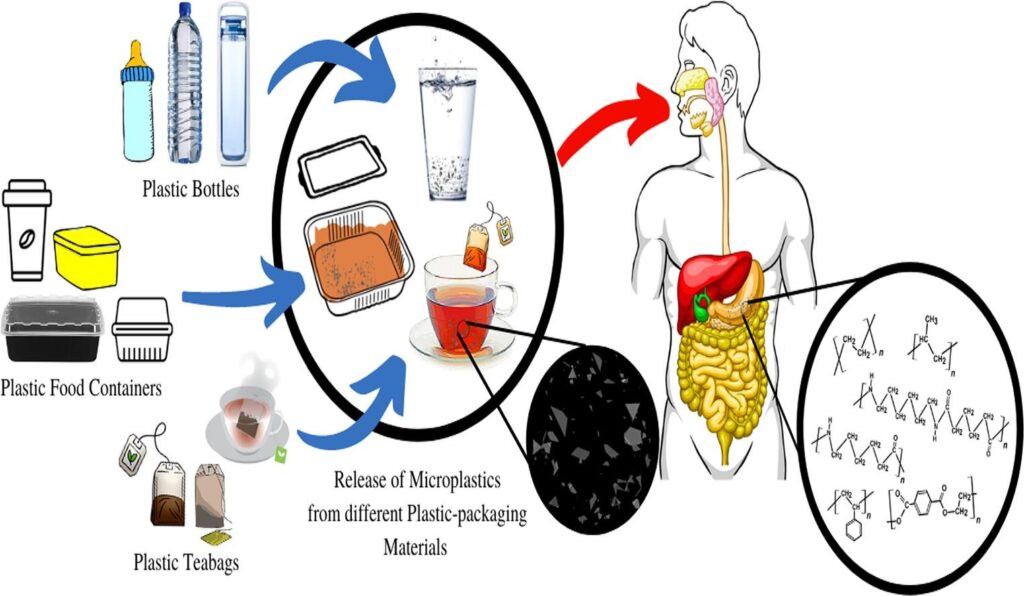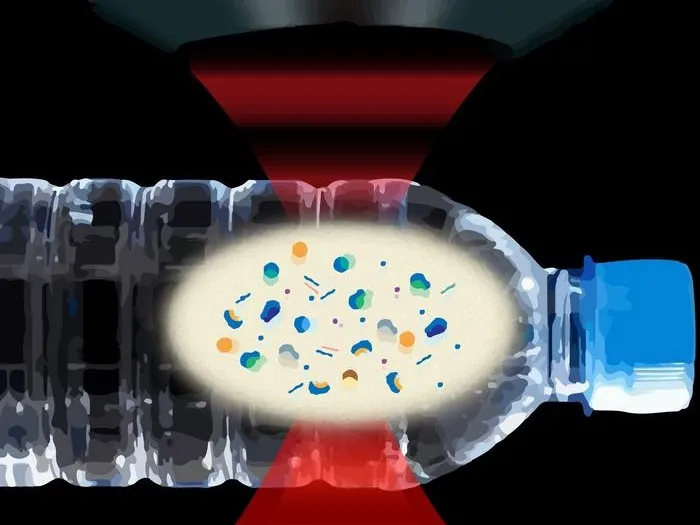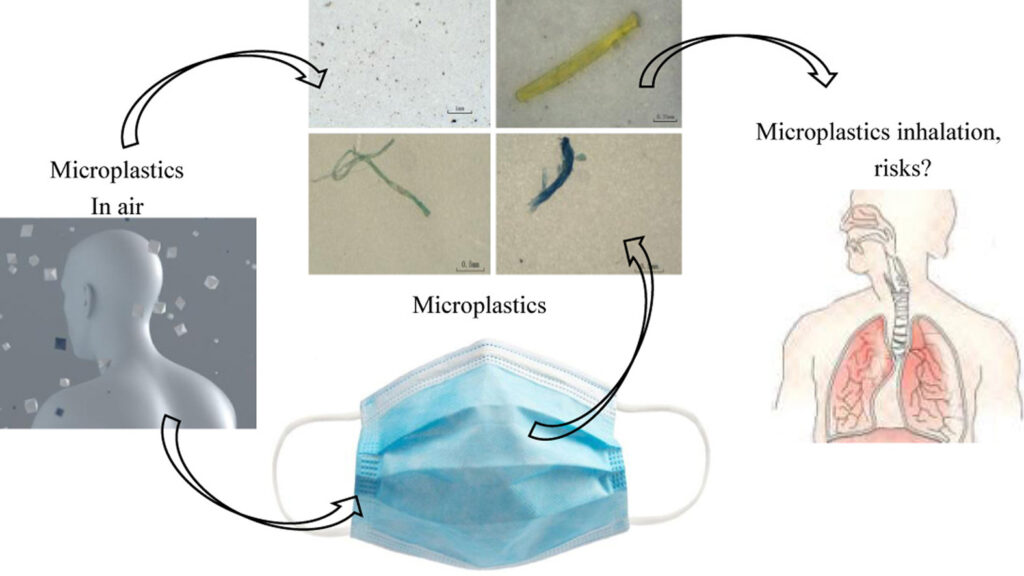
Plastics are everywhere—from the packaging we use to the products that make our lives convenient. But behind this, its widespread manufacture and extensive use have led to the silent spread of microplastics (MPs) and nanoplastics (NPs). Breaking down from larger plastic debris, these tiny particles are now finding their way to enter the human body by ingestion, inhalation, and even contact through the skin.
Although the present studies are still in its early stages, the results suggest possible detrimental impacts on several organ systems, such as the respiratory, gastrointestinal, cardiovascular, hepatic, and reproductive systems. This post will provide an overview of the potential health effects of MPs and NPs, their occurrence in human tissues, and the need to conduct further research to understand their impact on our health.
Introduction: The Global Plastic Crisis
Plastic output exceeded 368 million tons in 2019, indicating a consistent annual increase in global plastic use. However, much of the waste generated is not properly discarded, leading to concerns about the potential health impacts of micro- and nano-plastics on both human health and the natural surroundings. The global concern of potential hazards connected with the infiltration of plastics into every element of life and their subsequent degradation into smaller particles has emerged.
Plastics are produced by complex chemical processes, mostly involving polymerization and polycondensation of natural ingredients. These processes transform the fundamental components into extended polymer chains, resulting in materials that are exceptionally resilient. Plastics have a unique characteristic in that they do not readily return to their previous state, unlike most other materials. In order to be recycled, they must undergo additional chemical procedures. Industrial additives like pigments, plasticizers, and stabilizers are commonly used to fulfill specific application needs. These additives enhance the chemical stability of traditional plastics, resulting in their growing presence in the environment [1].
Plastics are composed of synthetic organic polymers, with the most common types being polyethylene (PE, both high and low density), polystyrene (PS), polypropylene (PP), polyvinyl chloride (PVC), polyurethane (PUR), and polyethylene terephthalate (PET). Additionally, various additives are often incorporated into plastics to enhance their properties, such as improving strength, adding color, or providing flame retardant capabilities such as phthalates, bisphenol A (BPA), polybrominated diphenyl ethers (PBDEs), etc [2]. Microplastics (MPs), ranging in size from 1 μm to 5 mm, and nanoplastics (NPs), with a size range of 1 nm to 1 μm, are emerging as significant environmental pollutants related to plastic waste [3].
How Humans Are Exposed to Microplastics and Nanoplastics
Human exposure to microplastics (MPs) and nanoplastics (NPs) occurs primarily through ingestion, inhalation, and dermal contact. Drinking water and marine products, such as fish and bivalves, are major sources of oral exposure, as MPs can bypass filtration systems and enter the food chain. Other foods, including honey, beer, and salt, have also been found to contain plastic particles.
MPs can also be ingested indirectly via personal care products like toothpaste and scrubs. Dermal exposure occurs through contact with contaminated water or products containing MPs/NPs, though skin absorption is unlikely except for the smaller NPs. Inhalation exposure arises from airborne plastic particles in environments such as urban areas, with atmospheric fallout being a potential source. While research on MPs in the air is limited, NPs have been more extensively documented in atmospheric studies [4].
The Detection of Plastics in Human Tissues
Plastics have been discovered to accumulate in several regions of the human body, as studies have revealed their presence in various tissues and organs. Plastic particles, such as PET, polystyrene, and polyethylene, have been found in human blood [5]. Moreover, microplastics have been detected in placenta samples [6] and human testes [7].
Polyethylene has been found in carotid artery plaque, indicating that plastics can build up in important parts of the body [8]. These findings emphasize the widespread presence of plastic particles and their ability to build up in various biological systems.
Potential Health Risks of Microplastics and Nanoplastics
While the study of microplastics and nanoplastics is still in its early stages, preliminary evidence suggests that their existence within the human body may provide several hazards. Many studies have been conducted in the past few decades to improve scientific understanding of the toxicity and implications for human health of exposure to a variety of natural and synthetic particles. Adverse effects associated with exposure by both inhalation and ingestion have been investigated.
A limited subset of NMP has been assessed, including epidemiological data on the adverse effects of occupational inhalation of synthetic fibers, such as nylon and plastic dust generated from PVC and polyurethane foam. While adverse effects, including accumulation of macrophages, frustrated phagocytosis, decreased lung function, interstitial lung disease, and lung cancer, have been reported, the studies have substantial limitations, such as limited cohort size and insufficient accounting for confounding factors. The data are also contradictory, as several studies found no significant relation between exposure and adverse effects.
Furthermore, occupational exposure to particles is not representative of the exposure of the general population. Caution is thus warranted in extrapolating results for different types of particles and exposure concentrations associated with occupational activities to indoor and outdoor environments (For more).
Controlled tests of the toxicity of NMP in vivo and in vitro after inhalation or ingestion indicate that high concentrations of some types of NMP elicit various biochemical effects, some of which depend on the physical characteristics of the particle (e.g., size, shape) and others on their chemical characteristics (e.g., solubility, surface chemistry, composition). However, only a few types of particles have been studied, and most research lacks enough detail to understand how these effects occur. The results may also be influenced by contaminants or chemicals mixed with the particles. More reference samples of NMP, representing what people are actually exposed to, are needed for better testing.
There’s also uncertainty about how much NMP gets absorbed into the body and how it impacts health, making further research essential. Studies on particles smaller than 10 μm, which are more relevant to everyday exposure, are necessary to accurately assess risks. (For more). Multiple cell culture and animal studies have highlighted the adverse effects of microplastics and nanoplastics on various bodily systems. These particles can impact the respiratory, gastrointestinal, cardiovascular, hepatic, renal, and reproductive systems [9].
A recent cohort study revealed that individuals who had microplastics and nanoplastics (MNPs) present in their carotid artery plaques exhibited a 353% elevated risk of experiencing cardiovascular events, such as heart attack, stroke, or death, in comparison to those who did not have MNPs. The research, which included 257 individuals undergoing surgery for significant artery constriction, revealed that over 50% of them had measurable amounts of polyethylene present in their arterial plaques.
The presence of these plastics was associated with increased inflammation and decreased plaque stability, highlighting the potential health hazards posed by plastic pollution in human tissues. However, as this was an observational trial, it may have multiple limitations, including factors like participants’ diet quality, their routes of exposure, BMI, and other confounders that could influence the results [10].
In conclusion, while we cannot state with high confidence the full extent of micro and nanoplastics impact on health, it may be prudent to minimize exposure as much as possible. Although completely eliminating these particles from our environment is nearly impossible, reducing exposure might be beneficial. Further research and trials are needed to better understand their effects and potential benefits.
Practical Ways to Reduce Exposure to Microplastics and Nanoplastics
While completely eliminating these particles from our daily lives is challenging due to their widespread presence, adopting certain strategies can help minimize their impact.
1. Avoid Microwaving or Heating Food in Plastics
Heating meals in plastic containers can result in the release of microplastics into your food. It was found that some containers could release as many as 4.22 million microplastic and 2.11 billion nanoplastic particles from only one square centimeter of plastic area within 3 min of microwave heating [11]. To prevent exposure, it is advisable to utilize glass or ceramic containers while microwaving or reheating.

2. Avoid Consuming Plastic-Packed Foods
Minimize purchasing food in plastic packaging, especially for long-term storage, as these may contain plastic additives and chemicals that could degrade over time[12].

3. Limit the Use of Plastic Water Bottles
Plastic water bottles are a significant contributor to the presence of microplastics, particularly when they are reused. Transition to stainless steel or glass bottles in order to minimize your consumption of microplastics.[13].

4. Reduce Use of Plastic Cutting Boards
During the process of cutting, plastic cutting boards have the potential to release microplastics into the meal.[14]. Wooden or bamboo cutting boards are preferable options for reducing exposure risks.

Consider N95 Mask Alternatives
Masks made from synthetic fibers like N95 can shed microplastics during use[15]. Switch to cloth-based or biodegradable alternatives when possible. Otherwise, N95 masks have their own advantage by reducing the risk of multiple diseases[16].

Summary
Microplastics (MPs) and nanoplastics (NPs), emerging contaminants derived from plastic waste, can infiltrate the human body through ingestion, inhalation, and skin contact. They may accumulate in critical organs and potentially damage multiple systems, including the cardiovascular, respiratory, and gastrointestinal systems after being detected in human blood, placenta, and arteries. Despite the fact that research is still in its infancy, findings indicate that there is an elevated risk of conditions such as inflammation and heart attacks.
Although the complete health consequences are not yet fully understood, the use of non-plastic food containers, limiting plastic water bottle consumption, and avoiding plastic packaging can help reduce exposure to these particles. In order to conduct a comprehensive evaluation of their long-term impact on human health, additional research is required.
References:
1. Yee, M.S., et al., Impact of Microplastics and Nanoplastics on Human Health. Nanomaterials (Basel), 2021. 11(2).
2. Meeker, J.D., S. Sathyanarayana, and S.H. Swan, Phthalates and other additives in plastics: human exposure and associated health outcomes. Philos Trans R Soc Lond B Biol Sci, 2009. 364(1526): p. 2097-113.
3. Sangkham, S., et al., A review on microplastics and nanoplastics in the environment: Their occurrence, exposure routes, toxic studies, and potential effects on human health. Marine Pollution Bulletin, 2022. 181: p. 113832.
4. Revel, M., A. Châtel, and C. Mouneyrac, Micro(nano)plastics: A threat to human health? Current Opinion in Environmental Science & Health, 2018. 1: p. 17-23.
5. Leslie, H.A., et al., Discovery and quantification of plastic particle pollution in human blood. Environment International, 2022. 163: p. 107199.
6. Ragusa, A., et al., Plasticenta: First evidence of microplastics in human placenta. Environment International, 2021. 146: p. 106274.
7. Hu, C.J., et al., Microplastic presence in dog and human testis and its potential association with sperm count and weights of testis and epididymis. Toxicological Sciences, 2024. 200(2): p. 235- 240.
8. Marfella, R., et al., Microplastics and Nanoplastics in Atheromas and Cardiovascular Events. New England Journal of Medicine, 2024. 390(10): p. 900-910.
9. Ali, N., et al., The potential impacts of micro-and-nano plastics on various organ systems in humans. EBioMedicine, 2024. 99: p. 104901.
10. Marfella, R., et al., Microplastics and Nanoplastics in Atheromas and Cardiovascular Events. N Engl J Med, 2024. 390(10): p. 900-910.
11. Hussain, K.A., et al., Assessing the Release of Microplastics and Nanoplastics from Plastic Containers and Reusable Food Pouches: Implications for Human Health. Environmental Science & Technology, 2023. 57(26): p. 9782-9792.
12. Alamri, M.S., et al., Food packaging’s materials: A food safety perspective. Saudi J Biol Sci, 2021. 28(8): p. 4490-4499.
13. Qian, N., et al., Rapid single-particle chemical imaging of nanoplastics by SRS microscopy. Proc Natl Acad Sci U S A, 2024. 121(3): p. e2300582121.
14. Yadav, H., et al., Cutting Boards: An Overlooked Source of Microplastics in Human Food? Environmental Science & Technology, 2023. 57(22): p. 8225-8235.
15. Li, L., et al., COVID-19: Performance study of microplastic inhalation risk posed by wearing masks. J Hazard Mater, 2021. 411: p. 124955.
16. Khan, A., et al., A Systematic Review of Whether the Use of N95 Respirator Masks Decreases the Incidence of Cardiovascular Disease in the General Population. Cureus, 2022. 14(10): p. e29823.